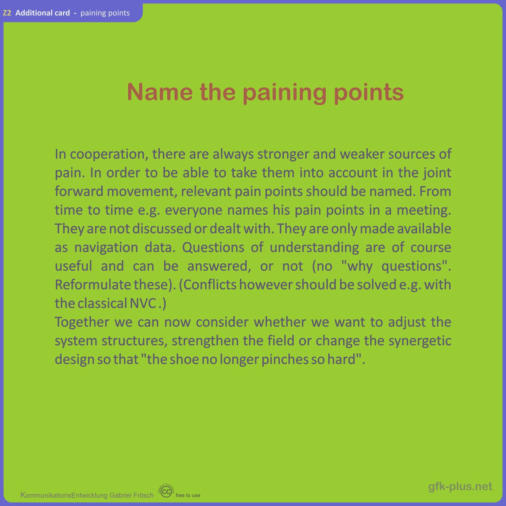
NVC+Elements: Schmerzpunte
In
NVC-plus,
there
is
an
opportunity
to
take
a
stand
on
an
unpleasant
situation
by
naming
the
pain
points
you
are
experiencing.
A
pain
point
is
not
a
no-go,
but
it
does
show
that
the
team
is
navigating
a
person's
boundary
issues.
If
that
is
clearly
named
by
the
person,
it
gives
the
others
the
opportunity
to
be
able
to
take
that
information
into
account
for
the
rest
of
the
journey.
However,
they
don't
necessarily
have
to,
because
otherwise it would be a no-go.
Some
may
need
support
or
a
bit
of
a
run-up
for
the
necessary
clarity
of
the
communication.
This
is
also
clearly
a
pain
point,
as
it
is
not
a
common
objection.
The
pain
point
is
where
the
factual
issues
and
the
personal reactions come together.
Additional card Z2



NVC-plus
has
some
tool
cards
and
a
few
additional
cards.
The
additional
card
Z2
is
the
card
that
explains
the
pain
points.
The
no-goes
and
must-haves,
on
the
other
hand, can be found on the tool card T2.1.
The
good
thing
about
using
pain
points
to
take
a
stand
is
that
you
take
responsibility
for
an
unpleasant
situation
and
do
not
project
it
onto
others
or
blame
it
on
circumstances.
So
you
don't
say
"You
didn't
turn
off
the
lights
in
the
closet
again.
Don't
you
ever
think
about
the
environment.
You
can't
do
that."
In
this
sentence,
the
other
person,
the
chamber
and
the
environment
are
present.
Only
oneself
has
not
found
a
place
in
it.
Therefore,
the
sentence
appears
as
a
dominant
claim.
If
one
says
instead,
"You
left
the
light
on
in
the
chamber
again.
This
is
a
pain
point
of
mine.
It
hurts
me
because
it
makes
me
think
of
the
environment,"
then
you
yourself
have
found
space
in
the
sentence.
The
Argentine
coach
Fred
Koffman
spoke
of
the
position
of
nowhere,
from
which
the
first
version
of
the
statement
was
spoken.
If
one
refuses
to
take
one's
own
position
while
at
the
same
time
being
more
emotional,
it
is
subsequently
difficult
to
communicate
with
one
another.
On
the
other
hand,
at
NVC-plus
we
want
to
avoid
long
discussions,
because
that
often
brings
far
too
little
in
relation
to
the
result.
So
one
sentence
is
enough
to
give
the
others
the
information
they
need
to
avoid
a
cliff.
If
they
don't
want
to
do
that,
it
can
be
endured,
or
tackled
at
the
right time with classic NVC (non-violent communication).
The map is part of a map set that you can find in the book, in the app or in the downloads.



Organising projects with self-organised teams

In
NVC-plus,
there
is
an
opportunity
to
take
a
stand
on
an
unpleasant
situation
by
naming
the
pain
points
you
are
experiencing.
A
pain
point
is
not
a
no-go,
but
it
does
show
that
the
team
is
navigating
a
person's
boundary
issues.
If
that
is
clearly
named
by
the
person,
it
gives
the
others
the
opportunity
to
be
able
to
take
that
information
into
account
for
the
rest
of
the
journey.
However,
they
don't
necessarily
have to, because otherwise it would be a no-go.
Some
may
need
support
or
a
bit
of
a
run-up
for
the
necessary
clarity
of
the
communication.
This
is
also
clearly
a
pain
point,
as
it
is
not
a
common
objection.
The
pain
point
is
where
the
factual
issues
and
the
personal reactions come together.
Additional card Z2

NVC-plus
has
some
tool
cards
and
a
few
additional
cards.
The
additional
card
Z2
is
the
card
that
explains
the
pain
points.
The
no-goes
and
must-
haves,
on
the
other
hand,
can
be
found
on
the
tool
card T2.1.
The
good
thing
about
using
pain
points
to
take
a
stand
is
that
you
take
responsibility
for
an
unpleasant
situation
and
do
not
project
it
onto
others
or
blame
it
on
circumstances.
So
you
don't
say
"You
didn't
turn
off
the
lights
in
the
closet
again.
Don't
you
ever
think
about
the
environment.
You
can't
do
that."
In
this
sentence,
the
other
person,
the
chamber
and
the
environment
are
present.
Only
oneself
has
not
found
a
place
in
it.
Therefore,
the
sentence
appears
as
a
dominant
claim.
If
one
says
instead,
"You
left
the
light
on
in
the
chamber
again.
This
is
a
pain
point
of
mine.
It
hurts
me
because
it
makes
me
think
of
the
environment,"
then
you
yourself
have
found
space
in
the
sentence.
The
Argentine
coach
Fred
Koffman
spoke
of
the
position
of
nowhere,
from
which
the
first
version
of
the
statement
was
spoken.
If
one
refuses
to
take
one's
own
position
while
at
the
same
time
being
more
emotional,
it
is
subsequently
difficult
to
communicate
with
one
another.
On
the
other
hand,
at
NVC-plus
we
want
to
avoid
long
discussions,
because
that
often
brings
far
too
little
in
relation
to
the
result.
So
one
sentence
is
enough
to
give
the
others
the
information
they
need
to
avoid
a
cliff.
If
they
don't
want
to
do
that,
it
can
be
endured,
or
tackled
at
the
right
time
with
classic
NVC (non-violent communication).
The map is part of a map set that you can find in
the book, in the app or in the downloads.




NVC-plus Painpoints


Organising projects with self-organised teams


























